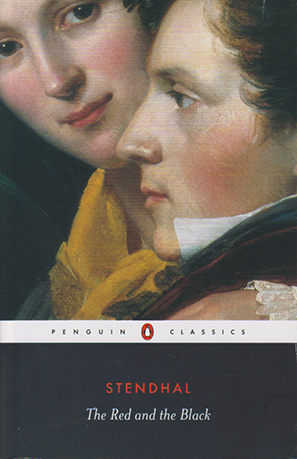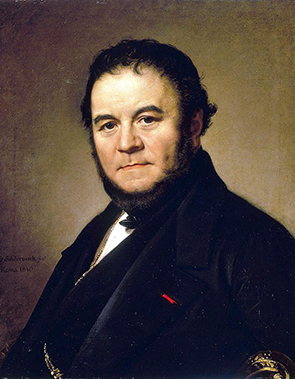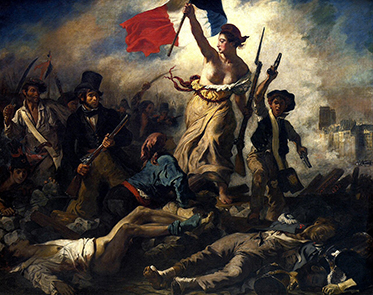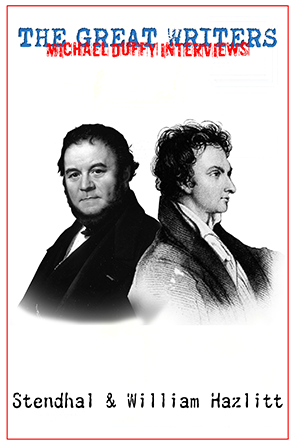
ISBN:9780140447644
Le Rouge et le Noir, Chronique du XIXe siècle

- Category:19th Century Novel, Romance Fiction
- Date Read:16 February 2024
- Year Published:1830
- Pages:532

Stendhal, I have read, regarded revealing the plot of a novel as a form of theft. Very little of the story is revealed in this review of the novel, and certainly no major plot points at all.
Le Rouge et le Noir, Chronique du XIXe siècle (translated as The Red and the Black in English), was Stendhal’s second novel and is credited as being one of the first examples of the truly modern form. Stendhal’s use of multiple perspectives and a realistic psychological representation of his characters was a noticeable progression from omniscient narration that marked a lot of literature of the time. This is one reason why this novel should appeal to modern readers. Apart from that, the setting for the novel is at a particularly important juncture in history, but you don’t need to know a great deal about the period to enjoy the novel. It can be read as an historical document of the time, but it can also be enjoyed for its characters and the tortured romances that are the focus of the story.
As to its historical significance, the subtitle of Stendhal’s novel, ‘Chronicle of 1830’, suggests it is set around the events of the July Revolution of that year. The novel was published in November 1830, but its writing preceded the revolution. Stendhal was writing it in 1829 and he finished the novel prior to the revolution in July 1830. Why is this important? It is to dispel expectations a modern reader may have and focus on what the novel actually is. Readers may be more familiar with Victor Hugo’s Les Miserables and the popular musical based upon it. Hugo weaves a story of love and personal redemption into the events of the June uprising of 1832, a failed anti-monarchist rebellion against Louise Philippe, who had been installed as King in the July Revolution of 1830 after Charles X was forced to abdicate. One of the songs in the musical even seems to echo Stendhal’s title:
- Red, the blood of angry men!
- Black the dark of ages past!
- Red, a world about to dawn!
- Black, the night that ends at last!
But Stendhal’s novel isn’t overtly revolutionary: the story does not even reach as far as the events of the revolution, itself. There are a few chapters in which Julien Sorel, the novel’s protagonist – “our hero” as Stendhal frequently calls him – is sent on a daring mission by his employer to deliver a message pertaining to plans for an uprising. Clearly Stendhal was aware of political unrest as he wrote. But when Julien isn’t under immediate threat his mind returns to his personal troubles: his thoughts and emotions entirely consumed by key women in his life and his ambitions.
The Red and the Black follows the fortunes of Julien Sorel as he rises from humble beginnings in an obscure village, Verrières, where his father and two brothers run a sawmill. Julien is beaten by his father for slacking off and reading, and by his brothers out of jealousy. But his skills and knowledge are instrumental to his growing successes as he eventually enters Parisian society, with all the opportunities that that brings. Julien uses his knowledge of Latin and his phenomenal memory to provide him with opportunities: first as a tutor to the children of M. and Mme de Renal; later as a priest in training at the Paris seminary, and finally in the employ of M. de la Mole, a marquis, who grows to trust Julien’s skills and discretion.
In part, this is a novel about ambition. But intrinsic to Julien’s ambitions are the women attached to powerful men. So it is also primarily a novel about love, too. These pairings and the novel’s title make it natural to speak of it in dichotomies: ambition/love; loyalty/deception; the army/the church. Julien is a good-looking 19 year old boy as the novel begins and he manages to attract and seduce the wife or daughter of both of his employers, M. de Renal and M. de la Mole, respectively, all the time aware that by doing so he is also furnishing his own ambitions. He rejects the marriage proposal of Elise, Mme de Renal’s lady’s maid, much to the surprise of Curé Chélan, Julien’s long-term spiritual advisor, because she can offer him nothing by way of advancement. Chélan, who suspects Julien’s ambitions, warns Julien:
If you dream of paying court to those in power, your everlasting ruin is assured. You could make your fortune, but you must grind down the poor, flatter the Sub-prefect, the Mayor, the man of reputation, and cater to his passions . . .
The subjugation of the poor is anathema to Julien’s class sensibilities and his admiration of Napoleon. Yet he is genuinely attracted to Mme de Renal and Mlle Mathilde de la Mole, both beautiful women. But Chélan’s warning is prescient. Julien cannot openly enjoy his romances in public, nor can he completely commit himself emotionally, always aware of his social status and never completely trusting the motives of his lovers. It results in a hot and cold cycle of attraction and rejection with both women, as Julien struggles with the reality of his position: that by using women he could easily give his heart to, he destroys the joy that he might otherwise have had:
Instead of being sensitive to the transports he aroused, and to the remorse that increased their intensity, he constantly had the idea of duty before his eyes. He dreaded fearful remorse and eternal humiliation if he deviated for one moment from the preordained model he wished to follow. In short, it was precisely that which made Julien a superior being that stopped him enjoying the happiness that lay at his feet. He was like the girl of sixteen with a charming complexion who, going to the ball, is silly enough to wear rouge.
I think this is where the original French title – Le Rouge et le Noir - is more helpful. There is a tendency to interpret the title as a reference to “the tension between the clerical (black) and secular (red) interests of the protagonist” (from Wikipedia), or “the conflicting choice he is faced with in his quest for success: the army (symbolized by the colour red) or the church (symbolized by the colour black)” (from Britannica). Patrick Pollard in his article Colour Symbolism in “Le Rouge et le Noir” addresses the difficulty of the title – that Stendhal gives us no guidance on how we might interpret it – and offers various explanations concerning ‘red’, including that it represents the successes of Napoleon’s army, Jacobism and even the red and the black of the roulette wheel, representing fate.
Whatever the interpretation of the title, I think it needs to accommodate Julien’s conflicted psychological states brought upon by his ambition, his sensitivity to class, his contempt for Parisian Society that supports him, and his conflicted motivations in his relationships with women. It’s hard to discuss any aspect of his character without the discussion bleeding into each other issues as well.
When Curé Chélan’s warns Julien (above) of the incompatibility of ambition with the role of a priest, a career Julien expects to enter, we understand by the repeated references to Julien’s black clothing – the black cloth worn by priests at this time in France – and the significance afforded it by his employer, that black represents something purer and untainted by ambition and society. The clothing of a priest is merely the most obvious form of this symbolism. Yet there is no strong counter-association with ‘red’ (as written in English) and a clear symbolic target. If it represents a secular interest, then secularism is most obviously evident in Julien’s ambition, the antithesis, according to Curé Chélan, of Julien’s calling. But his ambition is also strongly associated with his romantic affairs, a subject that finds ready association with red in popular culture. But ‘red’, the specific English word in translation, finds little association with love or passion in the novel, except for one scene in which Julien quickly gains the interest of Amanda, a barmaid, when he first enters Paris. Amanda is described as “very red”, but this might just as well be from stress, and her profession of love may be a means of moving Julien along (“Leave the café at once or I won’t love you; but I do love you a lot, really.”), since she has just interceded to prevent Julien becoming embroiled in a duel.
Yet Stendhal’s few references to ‘rouge’ in the novel – the cosmetic used for colouring cheeks – are significant. There is the reference made above, likening Julien’s ambition to a cosmetic which spoils rather than enhances his enjoyment of romance. The word first appears in the novel in the epigraph of the chapter before the above quote: Chapter 14. The epigraph attributed to Polidori reads, “A young girl of sixteen had a rose complexion, and she put on rouge.” Of course, we understand, for a young girl of this age, this is unnecessary. In this chapter Julien has an awkward moment with Mme de Renal, and to counter this he, “believed it his duty to give Mme de Renal a kiss.” These repetitions of ‘rouge’ and ‘duty’ support the representation of Julien as a mendacious and vacillating lover. The black of the priesthood, separate from worldly ambition, has integrity. But desiring – love, success, wealth – creates a different relationship with the world which is predicated upon abasement. Coming from a low working class, Julien might honourably pursue a career as a priest or soldier – both professions appealing to him – but instead, he chooses to use his youth and wits to manipulate and rise in the world.
This is paralleled in the figure of Mme Valenod, wife to the new mayor of Verrières, both minor characters with important roles to play in the novel. The Valenods represent the acquisitive, scheming aspects of French culture. In fact, their attempt to persuade Julien to become tutor to their children whom they wish to “acculturate” (‘éduquer’) reveals most of what we need to know about their pretensions and their relationship with Julien. Like Julien, they are aspirational, and Mme Valenod might be read as a female version of him, the only other character in the book with whom rouge is associated. She wears rouge whenever she knows she will meet Julien. “I believe she has designs on your heart,” Mme de Renal remarks to Julien of Mme Valenod.
These aspirations are also a product of French society during the Bourbon period. Julien is a Bonapartist and he conceals his contempt for the rich: “The history of their ancestors raises them above common feeling, and they do not have to be always worrying about making a living.” And added to that is Julien’s feeling that, “My life is just a succession of hypocritical poses.” He despises the hypocritical poses of the French salon, of the meaningless interactions and affected mannerisms. In a brief affair with Mme de Fervaques Julien makes use of advice on how to act, and a series of pre-written letters which allow him to affect an air of ennui and carelessness that will draw Mme de Fervaques to him. It matters little that some of the letters he copies out have no bearing on what is happening or being said between them. Everything in Parisian society is style over substance.
In Julien’s mind, the restoration of the monarchy in 1815 also reinstated social inequality. Julien carries a portrait of Napoleon with him, despite the dangers of doing so, and takes Napoleon as his model. The abasement of love comes not just in its aspirational manipulations, but in its associations with class warfare. Emboldened by Mme de Renal’s encouragements, Julien imagines himself a Napoleon when dealing with her husband, demanding time off that he isn’t entitled too. When Julien imagines greatness, it is through the prism of his admiration for Napoleon: “It was the destiny of Napoleon – would it one day be his?” The toadying submissions of the poor to the rich make him long for a more dignified course:
Oh Napoleon! In your day, how sweet it was to rise to fortune through the dangers of battle! – but to heap up the sufferings of the poor in this way!
But as the full French title suggests, Stendhal’s novel is also about the 19th century, and there is a sense that as the century has transformed since Napoleon, the culture has become debased and lacks honour. While we sense that Julien may agree with Rousseau on principle – the idea of ‘natural rights’ suggested in The Social Contract – he also understands that the principle has been debased in the service of class. Because without the means to enforce a right, it is meaningless:
There is only a right when there is a law forbidding something or other on pain of punishment. Prior to the law, there is nothing natural but the strength of the lion, or the needs of a creature who is hungry, who is cold – in a word, necessity . . .
But the law, as Julien sees it, favours the rights of the upper classes who repress the poor:
. . . when they are at Court, and it is a question of winning or losing some ministerial post, my upright salon dwellers lower themselves to crimes exactly parallel to those that the need to eat inspires in those two convicts . . .
It is the savagery of the salon that rules Paris, now, capable of tearing down a man’s reputation in the newspapers as much as a man was once torn down with violence: as a husband might now heap scorn on his wife rather than beat her. It is a civilised rule which, ironically, is more repressive of the poor. The repression is civilised and hidden and so much harder to overcome. This is possibly behind Julien’s attraction to duelling – he practices with pistols obsessively and is wounded in a duel: that therein lies a more noble and honourable way, representing the ‘natural’ rights of a man capable of holding his own. But it is also indicative of Julien’s approach to love, that gives primacy to conquest.
Julien fantasises that he is a second Napoleon, capable of rising through the social ranks (“Under Napoleon I would have been a sergeant; among these future cures I’ll be Vicar-general”). It is therefore not surprising that the imagery surrounding sexual conquest is militaristic. When he plans his sexual conquests he imagines himself a general planning a military campaign, and each move as a tactical move, while he imagines the fine dresses and the looks of beautiful women as “feminine artillery”. It is little wonder, then, that the word and its concept – ‘duty’ – becomes conflated with love.
So Stendhal’s novel is not about the revolution, per se, but it does capture the spirit of the time preceding it. Napoleon is gone, but he is still recent enough to represent an ideal to young men like Julien, while the hypocrisy and cant of Bourbon society represents refinements that are repressive and rapacious. If Stendhal were English he might well have likened Napoleon to Byron, a Romantic figure whose personality and capabilities are defy convention.
But Stendhal does offer us an alternative Byronic hero, a role Julien proves incapable of filling, in the figure of Boniface de la Mole, a romantic martyr who dies three hundred years before the events of the novel, but whose romantic ideal moves Mathilde’s heart. This is part of why Mathilde becomes such an interesting character, despite Julien’s initial contempt for her. Mathilde is capable of looking beyond Julien’s social class and the disadvantages of a match with him. Despite his suspicions, we see she is in love with him and that she is driven by ideals Julien consistently fails to live up to. When Julien sees Mathilde wearing black he is confused because he is unaware of anyone having died that would require her to wear mourning. Julian is told, however, that she wears mourning for her ancestor, Boniface de la Mole, each year on the anniversary of his execution. Boniface went to his death for his love of Queen Marguerite. Like Napoleon for Julien, Boniface represents an ideal for Mathilde: the idea of unalloyed love and passion. Like Julien, the hypocrisy of French society is anathema to Mathilde. But Mathilde has been born into a class Julien can only aspire to inhabit, yet she is willing to give up everything to maintain her ideals and to love Julien.
Stendhal, himself, was a Bonapartist and fought in Bonaparte’s army in the campaign against Russia in 1812. It is tempting when reading The Red and the Black to imagine Stendhal reassessing a younger self: understanding what is lost and knowing that it is gone. I think that’s why Julien’s ambition is doomed to fail. But there is a Romantic self, kept alive in the figure of Mathilde, who shows that ideals are still possible. I mean ‘Romantic’ in the sense of 19th century movement: an understanding of the self against in the tenets of the Enlightenment which were progressive, but not always as immediately positive as we might imagine. But I also mean ‘romantic’, too. There is much about French society happening in this novel, and allusions to a coming revolution that proved prescient. But if you like books with love stories, The Red and The Black is predominantly a book about relationships: their difficulty, their compromises and mistrusts, and the inflamed passions they inspire. I found myself irritated with the characters, sometimes – that they just couldn’t make up their minds about their feelings – but then when I thought about it in the context of their social setting and the class differences between them, the book became what it genuinely is: one of the first skilled psychological novels which gives a keen insight into the thoughts and feelings of its characters.


Read Michael Duffy’s ‘interview’ with Stendhal
